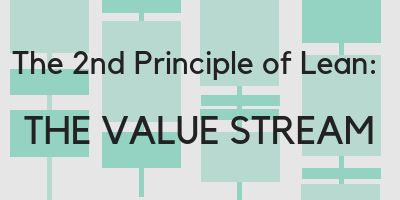This is part 2 in a series of blogs by Dean Doige on Lean Principles and their alignment with Digital Transformation. Have you read Part 1: Digital Lean Strategies?
The old adage of People, Process, and Technology still exists with Digital. Digital is not just about digital technologies or ”things”.
We all know layering new technology on old business processes is a recipe for disaster as all the bottlenecks, inefficiencies, and silos still exist. The digital technology simply creates more data faster and pushes it through the same old push based processes. Therefore, Digital requires us to examine our cross-functional enterprise processes and ensure they are ready for digital. How do we do this? Through the second principle of Lean: the Value Stream. The Value Stream is how the customer receives value from you the supplier, which is the end to end process triggered by the customer that ensures the delivery is received as quickly as possible. This requires systemic thinking as most customer centric value streams flow across organizational boundaries.
The challenge is, according to Info-Tech (2018), 55% of companies work in silos with each functional area making its own decision with respect to projects, initiatives, and capabilities. These silos are vertically built into organizational structures that point decision-making up, vertically. However, processes run horizontally across silos. According to Lean IT Pioneers Steve Bell and Mike Orzen (2011), the intent of these vertically designed organizations is cost reduction through economies of scale because the cost of systems and services are shared centrally. However, this creates a disjointed view of services as each functional area focuses on optimizing their individual processes but fail to look at the entire value stream (Bell & Orzen, 2011). This creates information being “thrown over the fence” to adjacent silos but not appreciating the receiver’s, or customer’s needs, ie: value from the process. When the ultimate customer does not receive the value they are expecting due to this disjointed process, the silos begin the blame and finger pointing game and the walls between the silos become larger.
I find a good example across all industries is onboarding new employees. In a traditional organizational structure, each silo has an onboarding process they conduct when the information is pushed to the next functional area. This leads to several vertically viewed processes, instead of one enterprise process.
When looking at your digital transformation and determining how to optimize business processes, start with the end in mind, ask yourself and the team, “If I were the customer of this process, would I be willing to pay for this task?” If not, why does it exist?
Brian Carroll (2008) says it best:
“When you believe that the next process is your customer, every team member has the obligation to never pass on inaccurate data, information, decisions, or material. It’s not
OK to fix my process by breaking your process.”
About the Writer:
Dean Doige, CET, LITP, MBA, brings over 21 years of experience in information systems across several industries. Dean is passionate about the development and advancement of the CIO profession and is a frequent write, speaker, and contributor on CIO, business, and IT issues.
References
Ballé, M. (2018, May 14). Any thoughts about lean and Industry 4.0? Retrieved from Lean Enterprise Institute: https://www.lean.org/
Bell, S. C., & Orzen, M. A. (2011). Lean IT: Enabling and Sustaining Your Lean Transformation. New York: Productivity Press.
Bonfante, L. (2018, May 30). Digital is Not a “Thing”. Retrieved from Heller Search Associates.
Carroll, B. J. (2008). Lean Performance ERP Project Management. Boca Ranton: Auerbach Publications.
Info-Tech Research Group. (2018, April 11). Plan and Execute a Digital Transformation. Retrieved from Info-Tech Research Group.
Loader, N., & Janssen, J. (2017, May). Lean IT Foundation: Increasing the Value of IT. Retrieved from Lean IT Association.
Velosa, A. (2018). Digital Twins: A Core Design Element to Scale Digital Business. Retrieved from Gartner CIO & IT Executive Summit, Summit 2018 Event Site.
